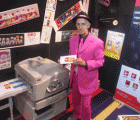According to EskoArtwork, with HD Flexo, printers can reproduce the full tonal range of offset, while maintaining easy set-up and implementation in production by reducing the need to edit images in prepress. Meanwhile, the plates produced with HD Flexo deliver consistent print quality compared to conventional plates and can be used in longer press runs, resulting in better press uptime.
The company continues that the flexo converter will notice many significant advantages with HD Flexo. The sharp detail in plates will produce high quality text and line art.
HD-Flexo can be applied on a wide variety of digital plates—all without compromising quality or having to adapt prepress specifically for the printing process. It does not require a significant capital equipment investment; just an upgrade of existing, installed equipment. This technology will be available on new Cyrel Digital Imagers (CDI) and can be upgraded on all existing CDI systems, according to EskArtwork.
The company also outlines that the HD Flexo brings some significant sustainability benefits, with HD Flexo direct digital platemaking, there is no manual lamination plate. Thus, there is no film to dispose of once the plates have been imaged.
Jürgen Andresen, EskoArtwork vice president, flexo business says, “HD Flexo makes life easy for brand owners and print buyers without compromising quality. It also makes life easy for trade shops and converters because with a safe, high quality process, they can compete with offset or other printing techniques.”
Comment below to have your say on this story.
If you have a news story or tip-off, get in touch at editorial@sprinter.com.au.
Sign up to the Sprinter newsletter


